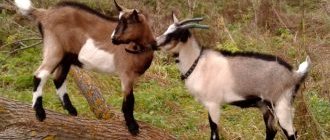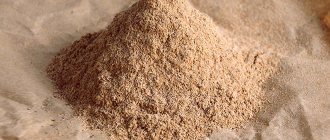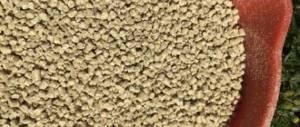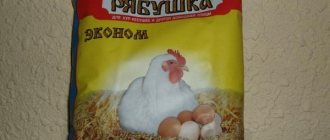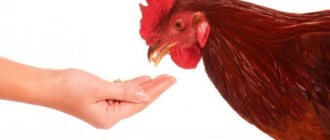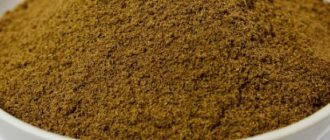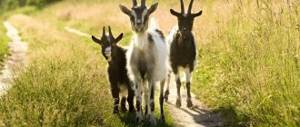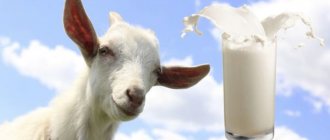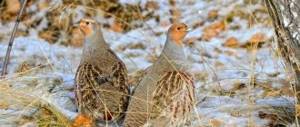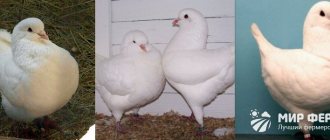To transfer young animals to rougher food, there is the so-called starter feed for calves. It occupies an intermediate place between an exclusively dairy diet and complete cattle nutrition. But accustoming a baby to such a diet is a troublesome task. After all, mixtures must be given strictly in doses, plus there are different mixtures for each age. Next, we will try to understand all the intricacies of this process, and practitioners will learn how to make compound feed with their own hands, and how much it costs.
What does the concept of compound feed include?
Combined livestock feeds are a mixture of different ingredients. They are selected according to a ready-made recipe and assembled using a certain technology. The goal is to obtain products that will contain the right amount and ratio of nutrients, and at the same time have a long shelf life.
Compound feed for cows
Each manufacturer uses its own formula for preparing mixed feed; most often the mixtures are made according to the following composition:
- based on grain crops;
- roughage;
- food industry waste;
- vitamins;
- mineral complexes;
- premix
Compound feeds are made strictly for a specific type of animal, and also depending on age characteristics. Thus, for dairy herds, compound feed corresponds to one composition, for calves - to another, for producers - to a third.
Features of feeding newborn calves
An evolutionary feature of cows, like all mammals, is the production of milk to feed their children. It is especially valuable in the first 2-3 days after calving, when colostrum is formed in the mammary gland. High content of proteins (formation of the calf’s immune system) and vitamins (provitamin A content is 50-70 times higher compared to milk). Colostrum is also rich in fats, carbohydrates and microelements. It fully satisfies the calf's energy and nutritional needs.
The main task of the livestock breeder is timely feeding of the calf. The best results in the safety of young animals were obtained when colostrum was given in the first hour of life. If you are late with feeding by more than 2-3 hours, then the mortality rate increases to 10-15, and the remaining young animals are stunted and show poor productivity.
The next task is the regularity of feeding. Calves should be watered 5-6 times a day, using individual teats. It is also important to monitor the diameter of the nipple canal - fast drinking leads to the following problems:
- weakening of the sucking reflex;
- licking foreign objects and other calves;
- swallowing large portions of milk;
- formation of curdled masses in the abomasum.
For feeding, both freshly obtained colostrum and frozen colostrum are used, but heated to 37 degrees before feeding. Constant use of fresh colostrum is impossible, since, starting from the 3rd day, its nutritional value drops sharply, so farms accumulate a supply of this product.
Colostrum is the most valuable livestock product; feeding a calf with it in the first hour of life will provide it with strong immunity and a high productivity rate.
It is useful to use collected milk, especially from old cows. Their colostrum is rich in antibodies and will create better immunity in the newborn. It is especially useful to use this product for weak calves and those obtained from heifers, as well as when the mother has clinical mastitis.
Calf feeding scheme:
- first dacha within an hour;
- use of prefabricated colostrum;
- the use of individual pacifiers or their mandatory disinfection;
- feeding 5-6 times a day, decreasing to 3-4 by the 15-20th day;
- adding vitamins to milk;
- gradual transition to roughage.
On the first day of life, the calf's body is most susceptible to external factors. This allows for the best absorption of many stimulants and supplements for rapid growth, vitamins and microelements. Within 24-36 hours of life, it is necessary to administer biological products with colostrum - nonspecific globulins and serums.
What is included in the feed
As a rule, basic feeds do not differ much from each other in their composition. The following table shows three different options.
| Component name | Recipe No. 1 (content in percentage) | Recipe No. 2 (content in percentage) | Recipe No. 3 (content in percentage |
| wheat grain | 25 | 20 | 21 |
| Winter barley grain | 31 | Not added | 20 |
| Corn grain | Not added | 20 | Not added |
| Sunflower meal | 10 | 10 | Not added |
| Soybean cake | 30 | 20 | 10 |
| Feed chalk | 0,5 | 0,5 | 1 |
| Mineral supplements | 3 | 3 | 3 |
| Soybean oil | 0,5 | 0,3 | Not added |
| Dry beet pulp | Not added | 26,2 | Not added |
| Pea grain | Not added | Not added | 45 |
You can use any type of grain, not just those listed in the table.
Compound feed for young animals
If you use high-quality “Start” compound feed in feeding calves, then in the future their productive qualities will be increased by 12% (when compared with other animals of the same age that were fed with other feeds). The most popular recipe for preparing starter feed is the following:
- wheat grain - not less than 20% of the total number of components;
- wheat bran – 20%;
- barley grain – 20%;
- oat grain – 10%
- mineral additives (calcium phosphate, table salt, crushed limestone) - 1% of each component.
Sunflower meal can be a completely suitable basis for feed. The oat grain is changed to wheat or barley, corn or millet are also suitable. From 42 days after birth, silage or stillage is added to the feed for calves. These components have a positive effect on the development of a young body.
Barley grain
Calves of this age category should receive carbohydrates in an amount of 70%. Protein accounts for no more than 15%. This ratio was not chosen by chance. A growing body needs a huge amount of energy, which it will receive from carbohydrates when they are digested.
Expert opinion
Vitamin deficiency in animals is difficult to identify immediately
According to Tatyana Sergeevna Kuznetsova, Doctor of Agricultural Sciences, project manager at Vitasol JSC:
– Experiments have shown that animals have external characteristic manifestations of deficiency of vitamins, mineral elements and other substances. But in practice, in young cattle, erased and complicated forms are observed, which do not allow a correct diagnosis. Very often, when there is a metabolic disorder, there are no external signs at all.
Insufficient or excessive intake of mineral elements into the animal body leads to a decrease in productivity, product quality, ability to use feed nutrients, ability to reproduce and resistance to disease. In such cases, only a biochemical analysis of blood parameters can give a reliable picture.
It is necessary to choose the right diet to avoid vitamin deficiency.
To do this, you can use natural supplements when feeding:
- Animals aged 10 days are allowed to give mashed potatoes with milk in the amount of 100-200 g per meal.
- After two weeks, fresh carrots are added to the diet - 200 g per day, gradually the daily norm is increased to several kilograms.
- Milk, which is the main food of the cubs during this period, can be mixed with honey, oatmeal, chalk and salt.
- You can also add semolina to the milk - 1 spoon per liter, so that the calf eats better.
- At the age of three weeks, the animal can begin to be fed with boiled vegetables - potatoes, beets, and it is advisable to mix them with hay.
- One month after birth, it is allowed to feed animals with raw vegetables.
It is also recommended to use various artificial mineral supplements. To prevent overdose and hypervitaminosis, consult your veterinarian before including them in your daily diet.
At the end of winter and beginning of spring, animals are especially lacking in vitamins. During this period, their diet includes fish oil, yeast, and glucose. The amount of these elements is calculated strictly in accordance with the weight of the animal.
To correctly calculate the amount of vitamins, you need to know their daily intake:
- 30,000–40,000 IU per day is the norm for vitamin A for a calf;
- daily requirement of vitamin D – from 3000 to 4000 IU;
- Vitamin “E” is recommended in an amount of 30–40 IU per day.
The normal weight gain for a calf per day ranges from 650 to 850 g.
- Recommended reading:
- Diet for dairy cows in winter and summer: how to prepare it correctly
- Protein content in cow's milk: what it depends on and how to increase this indicator
- Displacement of abomasum in cows: signs of the disease, methods of its treatment and prevention
Compound feed for adult cows
The mixture for adult livestock will have some differences (compared to the feed used by calves). The main components are as follows:
- grain as a base;
- protein source;
- mineral components.
Wheat, oats, millet, and barley can be added as grains. A large amount of protein is contained in sunflower meal or soybean cake; such additives are not so expensive. Alfalfa hay is added to some feeds.
Sunflower meal
Animals also need vitamin and mineral complexes; they are added in the form of premixes.
Today, there are a large number of different recipes that help prepare compound feed. When choosing the appropriate option, it is worth remembering that during the lactation period cows especially need calcium, phosphorus and protein. For pregnant individuals, the content of all these useful components should be in minimal quantities.
Amount of crushed milk for heifers and fattening bulls from 6 months
After 6 months, a heifer's feed per cow is rationed - no more than 2.5 kg per day (it is not necessary for her to become fat - this will negatively affect future milk yields).
Fattening bulls should be given 3 kg. Of course, you can do more, but few cattle owners do this (the cost of meat is more expensive).
In order to fatten a bull up to a year, you need approximately 1 ton of grain, up to a year and a half - 1.5 tons (at the rate of approximately 100 kg per month or 3.3 kg/day).
From experience(!): You can reduce the cost of fattening during the grazing period by reducing or eliminating grain altogether. And many owners successfully use this method. I don’t do this because fast fattening is important to me. On grain - this is intensive fattening, on one pasture - extensive, longer.
The ratio of components in the crushed mixture is the same as before.
Compound feed for breeding bull
This group of animals requires special care and feeding. Special feedstuffs are made especially for males used in breeding work, which include:
- oat grain – 30%;
- millet – 6%;
- wheat bran – 2.7%;
- corn grain – 8%;
- sunflower cake – 14%;
- feed yeast – 1%;
- fish meal – 3%;
- pea grain – 8%
- table salt – 1%.
Worth knowing. When replacing some of the feed with similar ones, it should be taken into account that producers should not receive:
- pulp;
- beer grains;
- bard;
- pulp;
- cottonseed cake or meal;
- cakes and meals obtained from plants of the cruciferous family.
What is compound feed?
All compound feeds are divided into several groups depending on the form of release. They can be of the following types:
- loose;
- granular;
- briquetted.
If we talk about the first type of feed, then this is an almost homogeneous mixture, in which the components were purified and crushed to the required size. This includes food familiar to cows:
- cakes;
- hay;
- straw;
- corn;
- legumes;
- bone flour;
- vitamin and mineral complexes.
They are combined according to the recipe in the required quantity. There are three types of grinding: fine, medium, coarse.
Granular feed is prepared from the loose composition, which was described above, using a special device - a granulator, which acts like a press with high pressure. The result is a large fraction called granules. They are cylindrical in shape and have the same dimensions.
Types of feed
If we compare loose and granulated feed, the second will have the following advantages:
- convenient transportation and storage;
- ideal for use on farms with automated feed distribution;
- the components included in the composition are not subject to mechanical stress and cannot self-sort;
- during feeding, granules are used more sparingly, they practically do not spill out of the feeders;
- nutritional components are more easily absorbed by the body;
- Thanks to additional processing, pathogenic microorganisms that could be in the original sources of raw materials are destroyed.
Briquettes are produced using almost the same technology as granules, but have a larger shape. They can be of different sizes. These feeds are based on hay and straw, accounting for at least ½ of all components. Molasses helps give the briquette its shape. A small disadvantage of this type is that it is crushed before distribution to animals.
Combined meal option
The combined nutrition option involves the use of combined feeds. Such feeds are divided into complete feeds (PC), concentrated feeds (C), additives (BVD) and premixes (P).
Complete feeds are designed to provide the animal with all the substances necessary for normal growth and development, as well as reduce feed consumption compared to natural analogues.
Read also: Winter plants for the balcony
Concentrated feeds differ from complete feeds in their increased content of a certain type of substance (for example, protein, micro-/macroelements, vitamins). Such feeds are given to the most productive animals to replenish nutrients.
Supplements are given to animals along with the main food in order to saturate their body with certain substances. Most often these are proteins or vitamins.
Premixes are ultra-concentrated additives that are added in small quantities to roughage to enrich them with certain substances.
Compound feed - for all occasions
Feeding adult cattle
For feeding adult animals, mixed feed is suitable, the number of which begins with the numbers 60, 61 or 66, depending on the type, period of life, sex and weight of the animal. So, for example, for breeding bulls the recipe K 66-1-89 is suitable, and for cows for the stall period - K 60-31-89. Separately, it is worth considering the productivity of dairy and beef cows when selecting the optimal feed option.
Over time, the feed should be changed - for example, a pregnant cow needs different substances after calving than before. Also, a reason for changing a prescription may be illness, a detected deficiency of a certain substance, or a transition to another age or weight category. In such situations, not only the type of food is changed, but also the serving size.
Healthy animals are the result of proper care and feeding
Features of feeding young animals
Young individuals are characterized by rapid growth and development, which determines some of the features of their feeding.
Firstly, as the animal grows, the size of the feed portion constantly increases. Secondly, young animals very quickly move into new age categories. So, in just a year and a half of life, an animal changes at least three types of food. In addition to the above features, the same rules apply for young individuals as for adults: the diet requires adjustment in case of illness, exhaustion, weakened immunity and other factors.
Calves require special attention
As can be seen from the article, over years of practice, scientists have developed an entire cattle nutrition system with many subtleties and nuances. To successfully raise productive livestock, you need to study materials on this issue and strictly adhere to the recommendations, proportions, and dosages. For those who have decided to make compound feed themselves, it is important to strictly adhere to the proportions and substances named in the recipe, because each ingredient has its own meaning.
Did you like the article? Save so you don't lose!
Currently, dry feed and mixtures occupy a significant place in the diet of domestic animals, partially or completely replacing traditional plant foods. The use of such concentrates has quite great advantages. The composition of feed for cattle includes all the substances necessary for the development of animals, and it is much more convenient to work with such feed.
Complete feed
This food contains substances that certain animals need for their development to occur normally. Compound feeds consist of grain. It could be oats, wheat or barley. What will be chosen specifically depends on the recipe and taking into account what consumer group of livestock will need the feed.
For example, small calves are fed prestarter feed, thanks to which the immune system develops to the maximum and the young body grows intensively. Over time, such food is replaced by the starter food. This feeding principle allows you to increase the productive qualities of each animal, which will have a positive effect on farm income.
Concentrated feed
When compared with complete feeds, concentrated feeds contain the following components in larger quantities:
- proteins;
- minerals;
- vitamins;
- cellulose.
This feed cannot replace other food, but acts as an additive to the main diet. This is a kind of feeding that improves the immune system and has a positive effect on the growth of livestock.
Use of compound feeds in cattle feeding
Concentrates can be divided into two groups. One of them is carbohydrate, the other is high-protein.
The first consists of corn grain, millet, wheat, barley. Carbohydrates content – 70%.
The second composition includes: soybeans, pea grain and other legumes, cakes and meal, protein - 25%.
